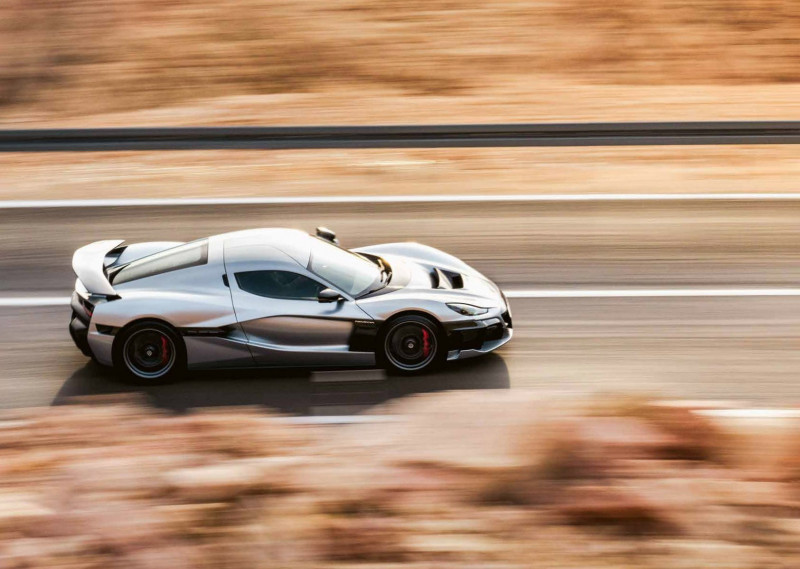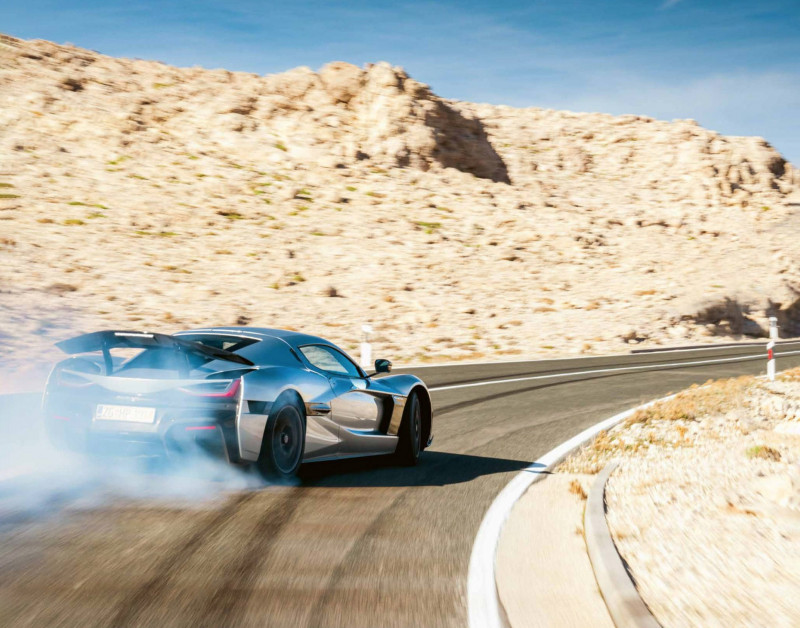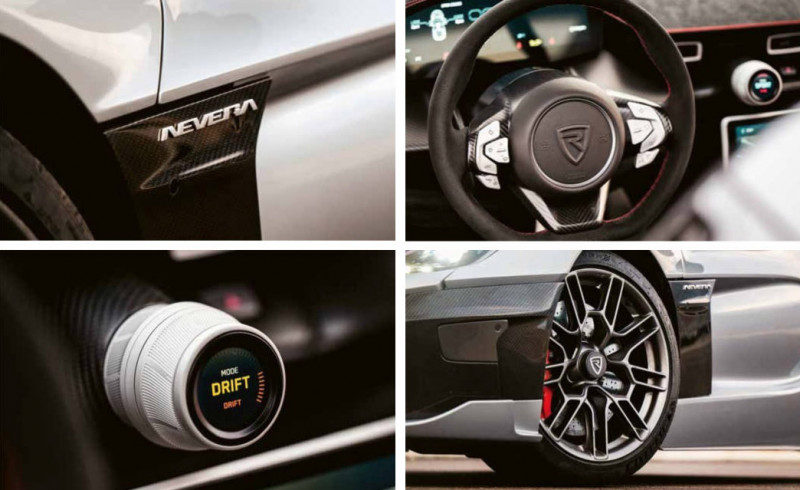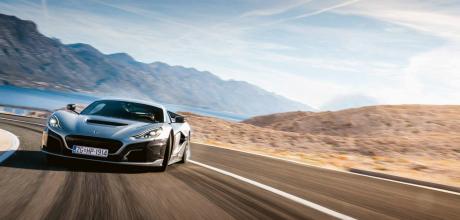2024 Rimac Nevera
Cracking 0-62mph (0-100 km/h) in less than two seconds and with an EV record top speed of 256mph (412 km/h), the Nevera’s numbers are simply stupendous. But how electrifying is it behind the wheel?
LIGHTNING SPEED
You can tell an awful lot about the Rimac Nevera in the first 200 m. Not how barkingly fast it is or how far it moves the game on in the rarefied world of the hypercar – those realisations come later – instead, how polished it is purely as a product. How well built it is, how sweetly matched the weighting and gearing of its steering seems, how synchronised its throttle and brake pedals feel, how easily you can climb in and out, how clearly you can see out of it, how beautifully damped it is and how refined it is at everyday speeds.

Even after 20 seconds, you can tell the Nevera rides perfectly for a car of this type. You can tell, too, how fundamentally well resolved it is from the way it filters all the unwanted stuff that goes on beneath your hands and backside, creating sound but not noise as it glides across the landscape … there’s a world of difference between those two things. From every move it makes in the first few moments you spend in it, the Nevera feels like the product of a marque that has been honing its craft for decades, not just a few years.

Yet, here it is, a brand new hypercar from what is still a largely unheard-of carmaker that originates not from Germany or Italy (or England) but Croatia – and it’s pronounced “REE-mahts”. If the revelations it unleashes in the first few hundred metres are enough to fry the space between your ears, they are nothing compared with what is to come. Trust me, when you finally let it rip, the Nevera does stuff no other road car can get anywhere near right now – not even close – and not only in a straight line, but also around corners and under braking. The box of secrets it contains is as wide and deep as it gets. After several days with this extraordinary car, I am still struggling to get my head around it.
What is the Nevera, and how come it’s as good as it is? As you probably know, it is powered entirely by electricity. At its core sits a carbon-fibre tub that’s not front-, mid- or rear-engined in the traditional sense because its 120 kWh battery pack is mounted across the floor to provide it with near-perfect 50:50 weight distribution. So, although the Nevera weighs a lot at 2 150 kg, the mass it carries is in the best possible place: nice and low in the chassis and not remotely stacked up at one end.

I’m not convinced you’ll want to know about the cylindrical cell formation of its 730 V battery pack or that it contains 6 960 individual cells cooled by liquid and made from lithium manganese nickel. It doesn’t sound as sexy as saying it’s propelled by a 6,5-litre V12 with cylinders lined with unobtanium and it revs to an ear-splitting 9 000 r/min. However, what you might be keen to know are the headline outputs this EV’s powertrain produces, along with the various methods the Nevera uses to transmit its prodigious energy to the road.
It boasts four electric motors and four gearboxes; each drives one of its four wheels. According to Rimac, the e-motors at the front each produce 220 kW and 280 N.m, which gives a total of 440 kW and 558 N.m across the front wheels. At the rear, the motors are somewhat beefier and produce 480 kW and 900 N.m … each. This gives a combined total of 960 kW and 1 800 N.m, purely at the back wheels. The combined total is quoted as 1 427 kW and 2 360 N.m, which takes a few moments to internalise.

The gearbox at the back is described by Rimac as a “double single-speed” unit. Essentially, a pair of one-speed gearboxes is mounted within the same housing and sits smack in the middle of the two electric motors. It is unfathomably clever.
Much like the suspension … on the surface, it appears refreshingly conventional in its design. It features double unequal-length wishbones at each corner with electronically adjustable dampers all-round. In reality, it is anything but conventional.
As you can imagine, traction is always going to be an issue with more than 1 400 kW on tap, and the Nevera’s uber-complex ESC system was tuned by chief engineer Miroslav Zrn evi and his team – some of whom are IT geniuses from India – to work extraordinarily well in practice. To a point where up to about 160 km/h, you never get full beans in the Nevera, not even in Track mode, not unless you switch everything off, but it’s not something you should do on a whim, trust me.
Instead, the ESC constantly hunts for the best grip at each wheel, allowing either a small amount of slip or a fair bit depending on which of the five drive modes you have selected. These are Range, Cruise, Sport, Track and Drift, and each mode provides a different set of maps for the dampers, throttle, ESC, steering and aero. The aero package – you’ve guessed it – is also pretty tricky and contains “active elements” at the front and rear, as well as along the underbelly of the car. Several hydraulically operated wings and ducts are automatically deployed as the car accelerates brakes and corners, and the whole lot is controlled by the same potent ECU that takes care of the ESC, dampers, throttle, steering, brakes… you name it.
Talking of brakes, the Nevera’s feature vast carbon-ceramic discs, with six-piston callipers at all four corners. Again, these are primarily operated by electronics (although if the e-systems fail, they work conventionally, as does the steering, which is nice to know). They form an integral part of the car’s ability to regenerate power on the move, so getting them to feel natural was never going to be a matter of a moment. In any event, it took Miroslav and his engineers “a seriously f***ing long time to get them right”, but as with so many other aspects of the Nevera, the result is key to the refreshingly analogue persona on the move. Rimac Technology does a lot of work for Porsche (it owns 24% of Rimac), among other manufacturers, so its engineers know about great brakes already. They were determined the Nevera would be similarly strong underfoot, even with the intricacies of regenerative braking.

All this has paid off, magnificently, because from the way it stops and how it steers, to the way it goes around corners and, yes, the ridiculous way it accelerates between those corners, the Rimac Nevera drives like no other road car … ever.
From a pure speed point of view, it changes everything. Its acceleration is so total and immaculate in its clarity that when you put your foot down hard for the first time, your brain briefly struggles to process it all. It feels like you’ve left a sizeable chunk of your conscious mind way behind. It’s so quick, it makes a 1 193 kW Bugatti Chiron Super Sport seem weedy by comparison. I know this, because we had a Chiron SS along with us when I drove the Nevera.
When the Nevera “goes”, your neck muscles strain to keep your head upright. You cannot help but clench your teeth hard in the same way you would if you were about to hit something coming towards you. Yet the freakiest thing is the acceleration does not tail away after a few seconds, as it tends to in all other EVs. Instead, the faster you go in the Nevera, the harder it pulls once the ESC system lets all four e-motors off the leash; it happens somewhere between 145 and 160 km/h, depending on what sort of road surface you’re on. At this point, the surge towards the horizon becomes even wilder and more intense. And it stays like this until the artificial speed restrictor intrudes at 352 km/h. You have probably read that Rimac clocked an unrestricted Nevera at 412 km/h, officially making it the fastest EV in the world; customers need special clearance to try that. I kept my foot in until about 290 km/h on a section of road Rimac had managed to close for our test, and it was still pulling as hard as it does at 80 km/h. Genuinely.
Years ago, I drove a then-contemporary Formula 1 car around Silverstone, and it was quite punchy in a straight line. Seriously, the Nevera seems quicker than that, up to 130–150 km/h, and every bit as rapid from there on. The raw numbers would suggest as much, too. Zero to 97 km/h takes 1,97 seconds, according to Rimac, while getting from 0–160 km/h takes four seconds flat. The standing quarter-mile comes and goes in 8,6 seconds – which is pretty crackers for a road car – and to hit 300 km/h, it needs less than 10 seconds.
As intoxicating as the Nevera’s crazed straight-line performance unquestionably is – to a point where I can’t imagine you could ever get used to it – what seems even more impressive, for me at least, is the level of engagement on the move. The way you can lean on it through a quick corner and sense how much torque is meted out through each wheel through the seats and via your hands is lovely. When you select Track or Drift mode, you can slide it about a bit if you fancy your chances or tighten the nose towards the exit of a corner by opening the throttle sooner and harder. And yet it does not seem to bite. It has been set up to deliver maximum edge but also as much feel through the steering and seats as possible. As a result, the Nevera seems like the world’s fastest and most sorted BMW M3, only with four times more of everything and much nicer steering into the bargain.
Making an insanely fast car is one thing, but making one that bubbles and has such delicacy to its controls at the same time … well, it is just pure genius. And if after a day of driving, you watch it reach full charge from almost zero in less than 20 minutes, it’s not long before the penny finally drops. Sure, the charging infrastructure is nowhere near where it needs to be but being able to top up the Nevera with another 480 km of range in around 18 minutes is almost as much of a game-changer. Especially when it costs no more than R600 to do so.
I’m still unable to wrap my head around just how polished the Nevera is, simply as a car to climb into and drive, and to appreciate it for all the stuff that doesn’t involve moving at Mach 2: things like the quality and precise engineering of its bespoke switchgear and the way its seats serenely purr into place; the perfection of the driving position; and that the air-con works to a T; the absence of any screen reflections; clarity of the digitised instruments; and the intuitiveness of the main touchscreen. All these are routinely fumbled by some of the world’s most experienced carmakers. Rimac has got all of it spot-on, straight out of the box. It’s extraordinary. The Nevera’s biggest drawcard is inevitably going to involve the way it goes. Not the way it’s made or the precision with which it is engineered or even the way it sounds. That said, despite there being no engine as such to listen to, I defy any petrolhead not to be beguiled by the sounds the Nevera makes on the move. It is a concoction of fizzes and distant screams that become louder and more intriguing the faster you go. It doesn’t sound like a Ferrari V12 at full chat – nothing does – but the more time I spent in it, the more I enjoyed its sounds. And to reiterate, we’re talking sounds, not noises. There is a huge difference between the two, as Miroslav is keen to point out.
In the end, it’s not the Nevera’s apocalyptic acceleration or its towering brakes, or even its surreal ability to deploy its energy so cleanly to the road below that blows your mind. Instead, it is how damn entertaining it is in the process, and this surely means it serves up the best of both worlds: the unrivalled straight-line insanity of a mega-high-output EV with the driver appeal of what often feels quite a lot like an old-school supercar.
The result? The Nevera is way more than just another mind-warping fast EV. It’s so good to drive in so many unexpected ways, it’s like it could easily have been created by Porsche’s GT department. I sincerely hope Rimac takes this the right way because, in our world, praise does not come any higher.
TECHNICAL DATA 2024 Rimac Nevera
- Motors: permanent magnet synchronous electric (2 x 220 kW front, 2 x 480 kW rear)
- Max Power: 1 427 kW
- Max Torque: 2 360 N.m
- Weight: 2 150 kg (665 kW/ton)
- 0-62mph 0–100 km/h: 1,97 seconds
- Top speed: 412 km/h
- Basic price: ± £1,72 million (± R36,6 million)
- + staggering speed; equally impressive dynamics
- — electric hypercars don’t come light (or cheap!)


